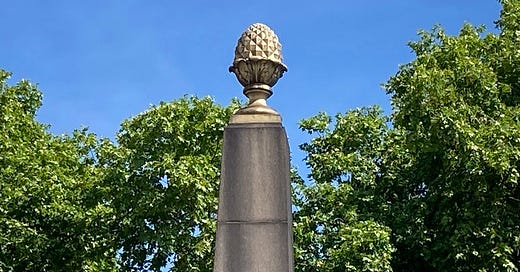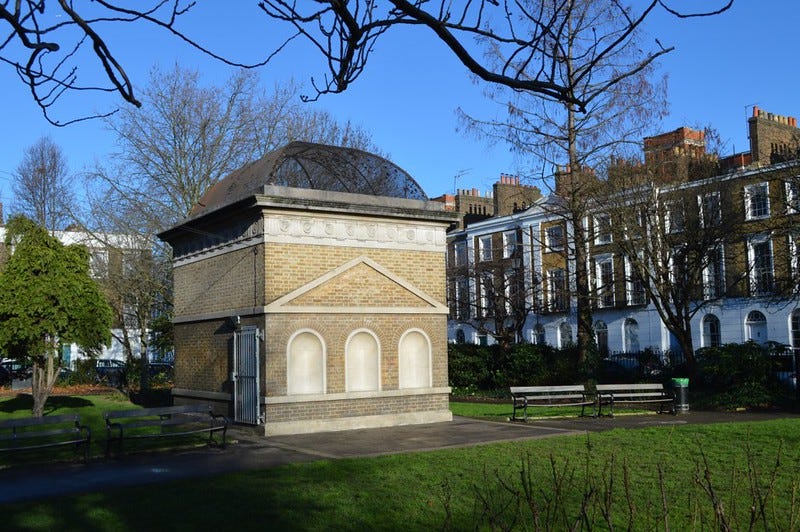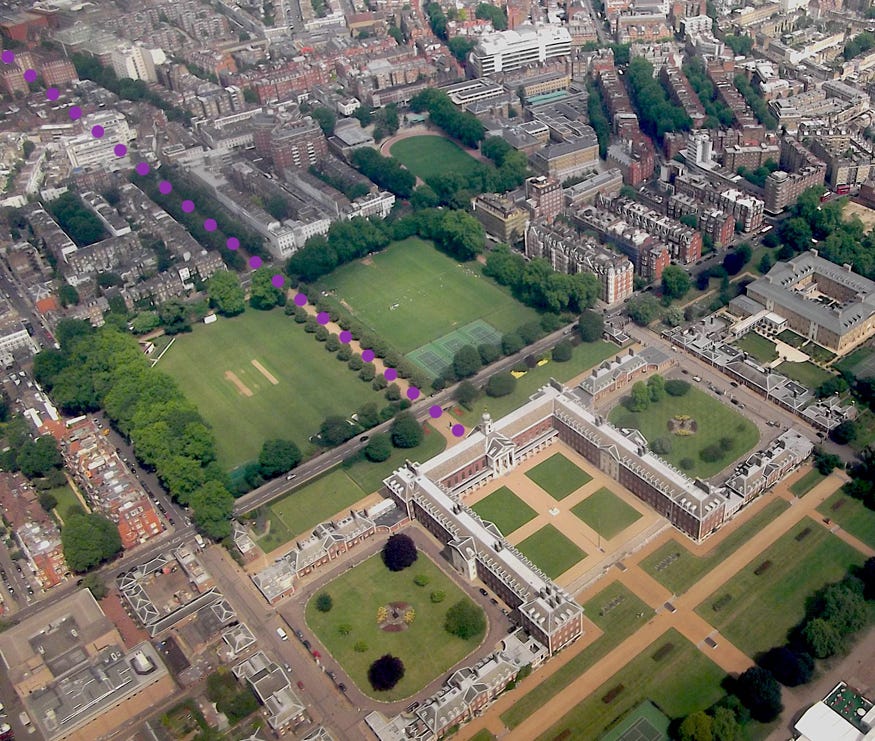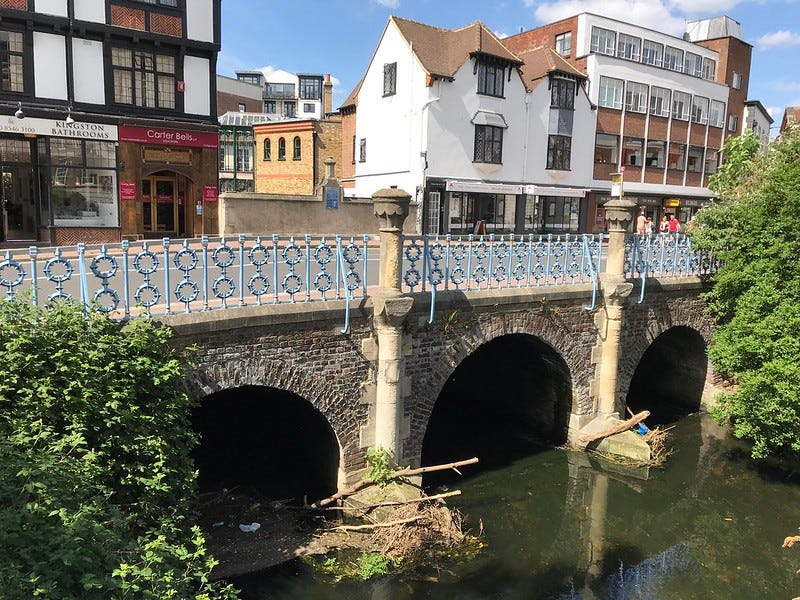An Historical Unusualness For Every London Borough (Part 3)
This week, Hounslow to Newham, via London's oldest bridge.
Welcome to Londonist: Time Machine’s Friday newsletter for paying subscribers, with a bounteous teaser for everyone else.
This week, we continue our journey through London’s 32 boroughs, which are 60 years old this month (April 2025). We encounter London’s oldest bridge, some mystery pineapples, a gothic birdhouse and two London peacocks that would not fit within it. That’s for the main section. First, a quick announcement and the History Radar…
📣 SITE VISIT: We’ve had a few places open up on the forthcoming visit to the Brunel Museum. If you’d like to snoop around the museum, listen to a short talk, visit the historic Brunel shaft, and then perhaps join me for a drink in an historic pub afterwards, then email me on matt@londonist.com. The event takes place on Thur 1 May, early evening, with a paid-bar inside the venue. This is open to paying subscribers and their plus-ones only.
History Radar
Upcoming events for anyone with an interest in London history.
🌸 FLORILEGIUM SOCIETY: Ever heard of the Florilegium Society? It's a group which has been documenting the plants at Chelsea Physic Garden through painting and drawing since 1995. On 28 April, to mark the society's 30th anniversary, its Honorary Keeper Gillian Barlow gives a talk about its history and purpose, including the scientific benefits of the artworks. 11am-12pm
🪶 TWO COCKNEY POETS: Poets John Keats and Thomas Hood were born within one mile — and four years — of each other. On 28 April, Guildhall Library offers a free illustrated talk looking at how, despite these similar beginnings, they went on to have very different lives and careers.
📚 POETS, PLAYWRIGHTS AND PUBLISHERS: On 29 April, Guildhall Library offers a guided walk focusing on the poets, playwrights and publishers of London. Meet guide Pete Smith outside Guildhall Art Gallery for the two-hour stroll.
🍺 CRYSTAL PALACE: To mark the 174th anniversary of the opening of the Great Exhibition on 1 May, pop along to the Paxton's Head pub (named after the architect of the Crystal Palace) near Hyde Park. The 'birthday party' will include a demonstration of a VR walkthrough of the exhibition, as well as various talks and a 'beating of the bounds' around the crystal palace's perimeter. FREE, 11am-5pm
✝ REMEMBRANCE: Over the coming days, London's marking the 80th anniversary of VE Day with several events and celebrations. At lunchtime on 2 May, the National Army Museum hosts a debate, Is Remembrance Still Working?, bringing together two grandchildren of high-ranking army officers from opposite sides of the Second World War, for a discussion about Remembrance, and how the end of the war was portrayed to the people on each side of the conflict.
🟤 SOUTHERN OUTFALL: Crossness Pumping Station has a special open day on 3 May themed around Southern Outfall, a site-specific artwork by volunteer Mhairi Vari, inspired by the confluence of sewer lines from across south London. Video installations, sound design, and sculpture feature in the piece, and there's a chance to meet Vari, ride the station's narrow gauge railway, take a vintage Routemaster from Abbey Wood station, view the current Great Stink exhibition and see inside the Beam Engine House.
🎉 VE DAY: Another of London's VE Day 80 celebrations takes over Stephens House and Gardens in Finchley on 4 May, aiming to replicate the VE Day celebrations which took place there in 1945. Maypole dancing, war film screenings, and a Finchley Society display of objects relating to wartime are all on the schedule, and at 6pm there's a recreation of this photo, taken in 1945.
🗣️ HACKNEY HISTORY FESTIVAL: This takes place over two weekends in May (10th-11th and 17th-18th), and sounds absolutely delicious. Events include a talk by Stoke Newington’s Amir Dotan on noticing the historical clues all around us, another on the Dalston peace mural (from people who are featured within it), and a walk through Hackney’s stone age landscape.
An Historical Unusualness For Every London Borough (Part 3)
Hounslow
These trimmed-bush peacocks outside St Mary the Virgin church seem custom-made for adolescent wordplay sniggers, but I’m not going to rise to the temptation. The yew-tree sculptures have stood in the churchyard since 1704, as indicated by the date beneath the left bird. Its playfellow perches above the year 1990, when the hedges were restored to former glory. Honestly, if these birds were anywhere near the centre of London, they’d be world-famous icons of the city. Because they reside in the relatively obscure Zone 6 village of Bedfont, few non-locals know they exist.
Islington
I do enjoy a bit of historical fakery. In a previous instalment, we saw the modern folly of Barking, which has the appearance of some kind of derelict brewery wall, but is in fact a Noughties pastiche. We have a similar situation in Gibson Square, Barnsbury. This ungainly building in the central garden tries to fit in with the 19th century terraces that surround it. Note the classical frieze, semi-circular niches and pseudo-pediment. The meshed roof gives the game away, however. The structure is a disguised ventilation shaft for the Victoria line. It was designed in the 1970s by Quinlan Terry, perhaps most famous in London for his work on Richmond riverside.
Kensington and Chelsea
The borough’s eponymous moieties were almost connected by a grand ceremonial avenue. William III was keen to link up the Royal Hospital Chelsea with his new palace at Kensington. Go-to architect of the day, Christopher Wren was all over the plans, having built the Hospital and remodelled Kensington Palace. He made a start on the Royal Avenue to connect them, but the scheme was never fully realised. To this day, the curtailed route can be seen running orthogonal to the hospital’s main access, across Burton Court, and along the road known as Royal Avenue. It terminates at King’s Road. Had it continued, the royal route would have sliced right through the land where the V&A and Science Museums were built. South Kensington would have developed very differently.
Kingston upon Thames
If ye seek London’s oldest bridge, look not to the Thames but to the River Hogsmill through Kingston. Its gentle flow is crossed by a multi-arched span known as the Clattern Bridge (perhaps because of the clatter of horses’ hooves that could once be heard on its cobbles). The bridge was built in 1175, making it one of London’s oldest structures of any type. It’s been much-patched and widened over the years, but the original Norman stonework is still down there, now bearing the weight of double-decker buses. Nearby, the Coronation Stone was used in the crowning of at least seven Anglo-Saxon kings. The deep history of London is not confined to the city centre.








